Travel
Las Fallas basically starts on the 1st of March with the first mascleta, a magnificent aprox 10 minutes explosive display of coordinated firecrackers and fireworks. Mascletas are held at 2pm in every neighborhood and repeated daily throughout the festival period, every day a different tune being played.
The most important of mascletas is the one in front of the Town Hall where the crowds gather hours in advance to get a privileged spot for the noisy show and where the pyrotechnicians compete for the honor of setting the biggest mascleta of them all on the last day of Las Fallas, the 19th of March.
There are many theories about the beginnings of Las Fallas, but the one I like best is this: it all started with the spring cleaning. The folks of Valencia used to mount in front of their houses piles of garbage gathered during the winter and then burn them. Slowly the piles of garbage started to grasp meaning and they became satirical and humorous social or political comments. They grew and the tourists started to come and the garbage piles became the amazing, colorful, hundreds of euros worth ephemeral monuments we can admire now every March.
Another stunning sight during Las Fallas are the beautiful traditional Valencian dresses the women exhibit during these days. But not only the women get all dressed up. The men and children do too. They are part of the Casal fallers and are called falleros. And during the festivities, there are thousands of people dressed in such costumes walking the streets of Valencia.
Being part of the event is a big deal. Not only that there are events organized all year round where they stand out, but during Las Fallas festival one gets lots of exposure. Every group is represented by a fallera, but the most important of them all is Fallera Mayor, the Queen of Las Fallas, a young woman chosen for her social skills and looks, to represent the community and the city of Valencia throughout the year.
The title of Fallera Mayor is an extremely prestigious one in Valencia and the competition is fierce and expensive. Fallera Mayor is always accompanied during the social events she attends by her court of honor made of 12 other lucky women. There is also a young girl, Fallera Mayor Infantil, who represents the children.
Beautiful as these traditional costumes look, they are also very expensive. The whole outfit (dress with golden thread, stockings, shoes, golden comb, jewelry, etc) can cost more than 20.000EUR. One visit to the hairdresser for the traditional hairstyle is about 400EUR.
Being a fallera is the dream of any Valencian girl. It's like being a local princess. Some of them start saving money for such a dress from a young age and with a bit of luck, eventually they see their dream come true.
Another important social event that takes place during Las Fallas is the offering to the Virgin. For two days in a row thousands of falleras and falleros head to the Plaza de la Virgen, just behind the cathedral, carrying flowers (especially carnations) from which the dress of the 14 meters high statue of Virgin Mary is made.
Because Las Fallas is a festival of light and fire, the street light contests could not miss. Walking on such a fine decorated street during the night is like stepping into a fabulous enchanted castle. Being amazed is 100% guaranteed.
- 5 Things To Do At Las Fallas Festival In Valencia
With over 3 million people attending every year, Las Fallas Festival from Valencia is considered to be the biggest street party in Europe. Las Fallas is celebrated from the 1st to the 19th of March, though to be honest, the most important and more fun...
- A Photo Essay Of The Best Fallas
Las Fallas is the biggest festival celebrated in the city of Valencia, Spain and it is held every year between the 1st and the 19th of March. It is a crazy and noisy, but family friendly festival. We literally took thousands of photos during this year's...
- Amazing Light Displays At Las Fallas Festival From Valencia
Las Fallas or the Festival of Fire is held in Valencia, Spain every year from the 1st to the 19th of March. People hit the streets dressed up in traditional costumes, build a huge statue of Virgin Mary out of flowers and enormous fallas...
- Las Fallas Festival, Valencia: Mascleta
Las Fallas or the Festival of Fire is held in Valencia, Spain every year from the 1st to the 19th of March. People hit the streets dressed up in traditional costumes, build a huge statue of Virgin Mary out of flowers and enormous fallas...
- Las Fallas In Short
Falla being installed in front of the Town Hall, Valencia 2010 Festivals are a great way to discover how the locals have fun and the traditions that form the core of a community. Las Fallas is very much such a festival, full of symbolism and with...
Travel
The Incredible Las Fallas. A Festival Of Noise And Fire
Las Fallas Festival takes place every year between the 1st and the 19th of March (16th to 19th are the most important days though) in the city of Valencia (Spain) and the nearby towns. Las Fallas is a traditional celebration in praise of Saint Joseph, the patron saint of the carpenters, but though it has a religious background, it is probably the craziest festivals out there and one of the most entertaining.
Spain is famous for its crazy fiestas. I mean if you have ever fancied a tomato fight or to put your life in danger running from angry bulls, then your dreams can easily come true in Spain. But simply burning the income and the work of a whole year and risking to set up on fire an entire city... How crazy is that?
The essence of Las Fallas
Every year in Valencia the locals raise funds and build over 700 enormous, humorous, satirical and very expensive papier-mâché monuments called fallas that are displayed in every other city square during the festival period, to eventually be dramatically burned in the middle of a big party on the 19th of March at midnight.
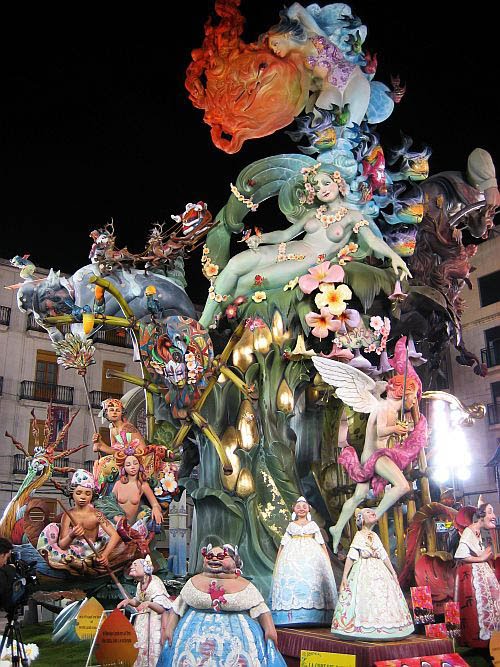 |
| "The Four Seasons", the winning falla of 2010 |
Las Fallas is an outstanding festival. The crowds that gather in Valencia every March from all over the world make Las Fallas an internationally recognized festival, worthy of being listed next to the Venice Carnival or the Carnival in Rio.
Mascletas
Las Fallas basically starts on the 1st of March with the first mascleta, a magnificent aprox 10 minutes explosive display of coordinated firecrackers and fireworks. Mascletas are held at 2pm in every neighborhood and repeated daily throughout the festival period, every day a different tune being played.
The most important of mascletas is the one in front of the Town Hall where the crowds gather hours in advance to get a privileged spot for the noisy show and where the pyrotechnicians compete for the honor of setting the biggest mascleta of them all on the last day of Las Fallas, the 19th of March.
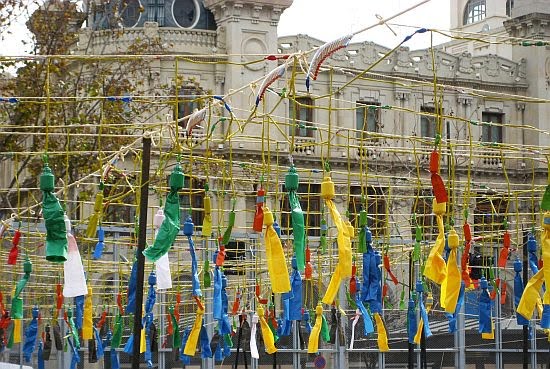 |
| Sacks of gunpowder ready to explode in front of the Town Hall /td> |
Food at Las Fallas
Las Fallas is all about bonding and keeping the community together, and what better way to do this than cooking a huge paella in the street? Paella is the first choice for any event here, as it was first cooked in Albufera, a lagoon not far away from the city. Therefore, eating a paella is one of the must-do things in Valencia for any visitor.
But the most emblematic Las Fallas food are the pumpkin buñuelos and the chocolate dipped churros. Basically food stands sprout like mushrooms at every street corner and days become a roller-coaster of fried dough. Medieval markets are also organized on the streets leading to the biggest fallas and here you can find other delicious regional goodies, like cheese, ham ans sweets.
Each neighborhood of Valencia has an organized group of people, the Casal faller, that 'works' all year long holding fundraising parties and dinners that will later be invested in a falla.
Every falla is made out of ninots (meaning puppets or dolls) and all are going to be burned except two (one from a kid's falla and one from a big falla) that are saved and displayed in the Fallero Museum from Valencia, next to the City of Arts and Sciences.
To make sense of what I said before about burning the work of a hole year... "The Kiss Between Earth And Sea" was 27 meters high, and was an impressive falla from 2010. It actually got the 2nd prize. It also cost about 600.000EUR.
But the most expensive falla ever, that actually got in the Guinness Book, cost about 900.000EUR and was the winner of 2009. So yeah, you can say these are money thrown out the window or more specifically, burned. Not everybody has the value to do that, I have to admit.
But the most emblematic Las Fallas food are the pumpkin buñuelos and the chocolate dipped churros. Basically food stands sprout like mushrooms at every street corner and days become a roller-coaster of fried dough. Medieval markets are also organized on the streets leading to the biggest fallas and here you can find other delicious regional goodies, like cheese, ham ans sweets.
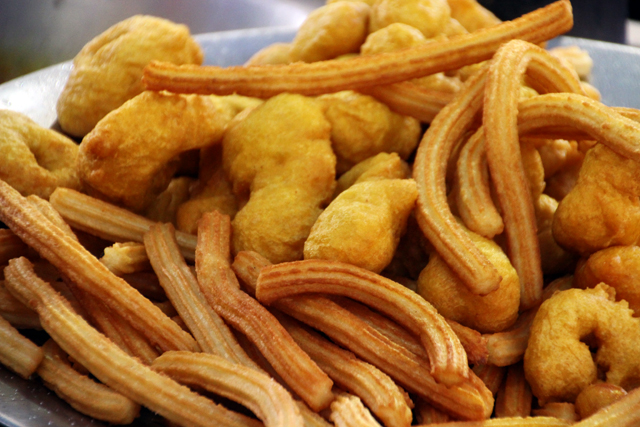 |
| Buñuelos and churros |
The fallas
Each neighborhood of Valencia has an organized group of people, the Casal faller, that 'works' all year long holding fundraising parties and dinners that will later be invested in a falla.
Every falla is made out of ninots (meaning puppets or dolls) and all are going to be burned except two (one from a kid's falla and one from a big falla) that are saved and displayed in the Fallero Museum from Valencia, next to the City of Arts and Sciences.
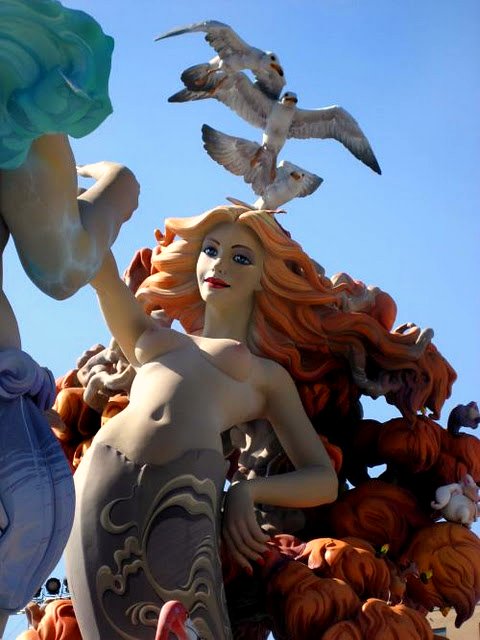 |
| "The Kiss Between Earth And Sea" a 27 meters falla from 2010 |
To make sense of what I said before about burning the work of a hole year... "The Kiss Between Earth And Sea" was 27 meters high, and was an impressive falla from 2010. It actually got the 2nd prize. It also cost about 600.000EUR.
But the most expensive falla ever, that actually got in the Guinness Book, cost about 900.000EUR and was the winner of 2009. So yeah, you can say these are money thrown out the window or more specifically, burned. Not everybody has the value to do that, I have to admit.
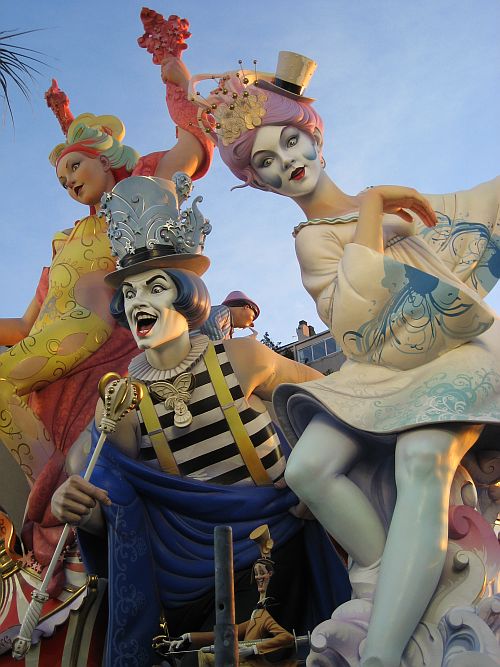 |
| One of the winning fallas of 2011 |
The beginnings
Falleras, falleros and the traditional costumes
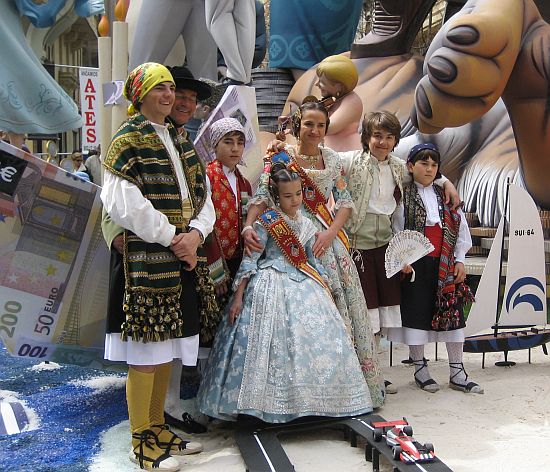 |
| Family of falleros in front of the falla they sponsored |
Fallera Mayor - the Queen of Las Fallas
Being part of the event is a big deal. Not only that there are events organized all year round where they stand out, but during Las Fallas festival one gets lots of exposure. Every group is represented by a fallera, but the most important of them all is Fallera Mayor, the Queen of Las Fallas, a young woman chosen for her social skills and looks, to represent the community and the city of Valencia throughout the year.
The title of Fallera Mayor is an extremely prestigious one in Valencia and the competition is fierce and expensive. Fallera Mayor is always accompanied during the social events she attends by her court of honor made of 12 other lucky women. There is also a young girl, Fallera Mayor Infantil, who represents the children.
Beautiful as these traditional costumes look, they are also very expensive. The whole outfit (dress with golden thread, stockings, shoes, golden comb, jewelry, etc) can cost more than 20.000EUR. One visit to the hairdresser for the traditional hairstyle is about 400EUR.
Being a fallera is the dream of any Valencian girl. It's like being a local princess. Some of them start saving money for such a dress from a young age and with a bit of luck, eventually they see their dream come true.
The offerings to the Virgin Mary
Another important social event that takes place during Las Fallas is the offering to the Virgin. For two days in a row thousands of falleras and falleros head to the Plaza de la Virgen, just behind the cathedral, carrying flowers (especially carnations) from which the dress of the 14 meters high statue of Virgin Mary is made.
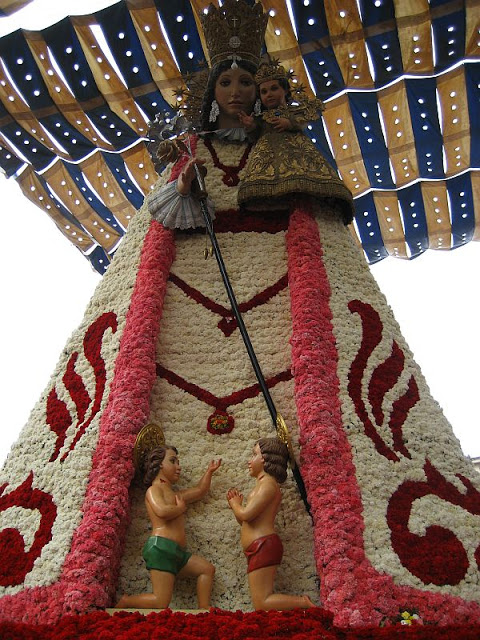 |
| Virgin Mary statue made out of flowers |
The light displays
Because Las Fallas is a festival of light and fire, the street light contests could not miss. Walking on such a fine decorated street during the night is like stepping into a fabulous enchanted castle. Being amazed is 100% guaranteed.
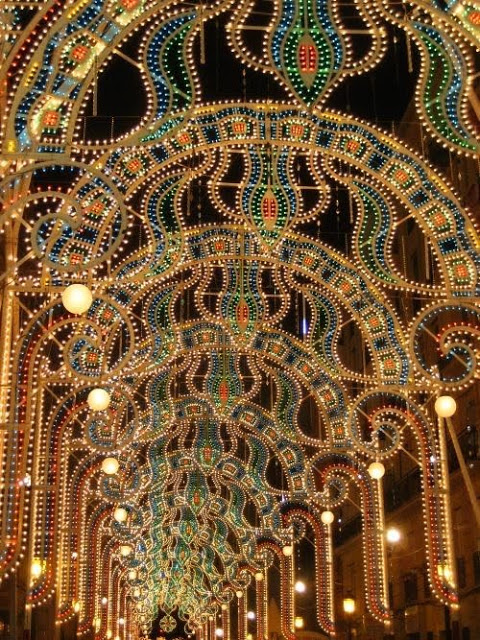 |
| Street participating in a street lights contest |
La Crema - burning the fallas
Eventually, all fallas are burnt. It is a sad moment, but also the time to let go. Seeing these works of art burning is always sad and tears often come to my eyes. With this act, Las Fallas comes to an end, but just not before an impressive fireworks display in front of the Town Hall.
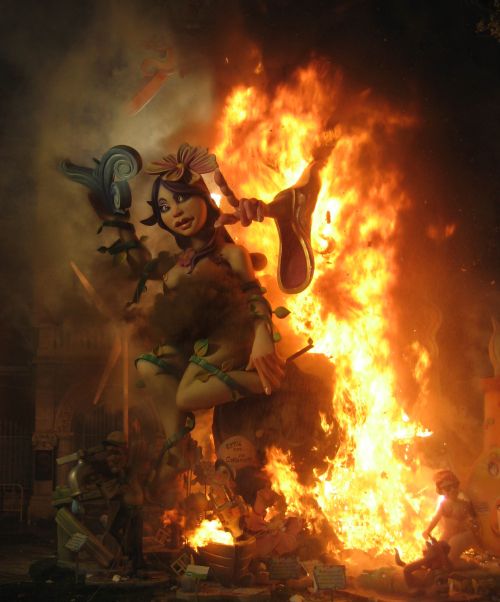 |
| Falla burning down to ashes - hot, hot, hot, only the firemen could get close to it |
Las Fallas is an amazing festival and every time I get to live it it warms my soul with all the marvelous and incredible things it means and offers. The fire that purifies the house and the spirits could not have a greater expression anywhere else. The rebirth of nature and the rebirth of the new human being, can not be accomplished in this lands except through fire, like a Phoenix spreading her wings towards a new beginning. Las Fallas is the most complex festivals that I know of and words will never make it justice. You need to live it to fully understand it!
- 5 Things To Do At Las Fallas Festival In Valencia
With over 3 million people attending every year, Las Fallas Festival from Valencia is considered to be the biggest street party in Europe. Las Fallas is celebrated from the 1st to the 19th of March, though to be honest, the most important and more fun...
- A Photo Essay Of The Best Fallas
Las Fallas is the biggest festival celebrated in the city of Valencia, Spain and it is held every year between the 1st and the 19th of March. It is a crazy and noisy, but family friendly festival. We literally took thousands of photos during this year's...
- Amazing Light Displays At Las Fallas Festival From Valencia
Las Fallas or the Festival of Fire is held in Valencia, Spain every year from the 1st to the 19th of March. People hit the streets dressed up in traditional costumes, build a huge statue of Virgin Mary out of flowers and enormous fallas...
- Las Fallas Festival, Valencia: Mascleta
Las Fallas or the Festival of Fire is held in Valencia, Spain every year from the 1st to the 19th of March. People hit the streets dressed up in traditional costumes, build a huge statue of Virgin Mary out of flowers and enormous fallas...
- Las Fallas In Short
Falla being installed in front of the Town Hall, Valencia 2010 Festivals are a great way to discover how the locals have fun and the traditions that form the core of a community. Las Fallas is very much such a festival, full of symbolism and with...
